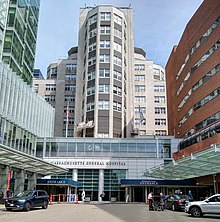Paul Dudley White
This article includes a list of general references, but it lacks sufficient corresponding inline citations. (August 2017) |
Paul Dudley White | |
|---|---|
 | |
| Born | 6 June, 1886 Roxbury, Massachusetts |
| Died | 31 October 1973 (aged 87) New York City, New York State |
| Alma mater | Harvard College Harvard Medical School |
| Scientific career | |
| Fields | Medicine Cardiology |
| Institutions | Massachusetts General Hospital |
| Notable students | S. I. Padmavati[1] |
Paul Dudley White (June 6, 1886 – October 31, 1973) was an American
Early life and education

White was born in
He then began his long association with the Massachusetts General Hospital through an internship in pediatrics and internal medicine. During that time he co-authored his first scientific paper, on the coagulation of blood, with Roger I. Lee. The Lee-White coagulation time is still used today as a method of measuring the speed of blood coagulation. In 1913, White was offered a Harvard traveling fellowship to study cardiovascular physiology with the eminent cardiologist, Thomas Lewis, in London. This experience, perhaps coupled with the earlier death of his sister from rheumatic heart disease and his father's death from coronary artery disease at age seventy-one, was to shape the rest of his medical career.
World War I

In
Academic career
This section needs additional citations for verification. (August 2017) |
White was appointed to the Harvard faculty as a clinical instructor in 1921 and quickly rose through the academic ranks to become assistant professor in 1933, clinical professor in 1946, and emeritus professor in 1949. He continued on the faculty of Harvard until 1956, although he had resigned his position as Chief of the Cardiac Service at the Massachusetts General Hospital in 1948 to devote time to the development of the National Heart Institute, following adoption of the National Heart Act, which was signed into law by President Truman in 1948.
White was recognized as a superb teacher and compassionate bedside physician. He published twelve books and more than 700 scientific articles. His most noted textbook, Heart Disease, was first published in 1931 and became a classic in the field. His interest in the electrophysiology of the heart would eventually pair him with Drs.
Advocacy work

White is viewed by most medical authorities as the founder of preventive cardiology. Appointed as President
White authored the Foreword to Ancel Key's 1959 book Eat Well and Stay Well.He was a moving force in the creation of the International Association of Cardiology, and later the International Cardiology Foundation. In 1949, he was named executive director of the National Advisory Heart Council. He was the chief consultant to the National Heart Institute from 1948 to 1955 and was a major impetus in the Framingham Heart Study, which was the first major epidemiologic work to identify risk factors in coronary artery disease.[6][7] He influential in establishing the National Institutes of Health.[8]
White received many international honors and was instrumental in establishing cardiology organizations throughout the world, even in the
White was a staunch advocate of the belief that
In his later years, White continued to travel and to speak about heart disease and, increasingly, about his concern for world peace.
Awards
White was elected an Associate Fellow of the National Academy of Kinesiology (née American Academy of Physical Education)[9] in 1961, and delivered the academy's R. Tait McKenzie Memorial Lecture the year before at their 1960 meeting in Miami Beach, Florida. His presentation was titled, "Health and Sickness in Middle Age".[10] Also in 1961,
Personal life
On June 28, 1924, White married Ina Helen Reid, a social worker whom he met while giving a lecture at the Smith College Training School for Social Work. They later adopted two children. White spent many summers at
Death and memorials
White died in Boston following a second
The United States Postal Service honored White with a 3¢ Great Americans series postage stamp on September 15, 1986. A 17-mile section of the Charles River Bike Path around the Charles River in Boston bears his name.
References
Footnotes
- ^ "Who was Dr SI Padmavati, India's first woman cardiologist who died at 103 - IBTimes India". International Business Times. 6 August 2023. Archived from the original on 6 August 2023. Retrieved 6 August 2023.
- PMID 23908843.
- OCLC 35814825.
- ^ "Medicine: Capsules, Dec. 30, 1957". content.time.com. Retrieved 25 January 2024.
- ^ "Paul Dudley White: Opened the doors for Ancel Keys worldwide". sevencountriesstudy.com. Retrieved 25 January 2024.
- doi:10.1038/nrd2667.
- ^ "About Dr. Paul Dudley White". stroke.org. Retrieved 25 January 2024.
- ^ "Paul Dudley White". wnyc.org. Retrieved 25 January 2024.
- .
- ^ Leaf, Carol Ann (1974). History of the American Academy of Physical Education, 1950-1970. Salt Lake City, UT: University of Utah. p. 102.
- ^ The American Presidency Project
- ^ "Dr. Paul Dudley White is Dead at 87". The New York Times. November 1973.
General references
- "Paul Dudley White". Dictionary of American Biography, Supplement 9: 1971-1975. Charles Scribner's Sons, 1994.
- Herman A. Snellen, "Birth and Growth of the European Society of Cardiology". European Heart Journal, vol. 1, no. 1, pp 5–7.
